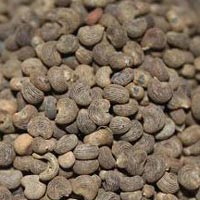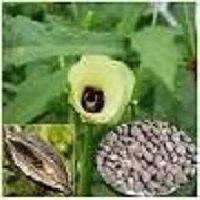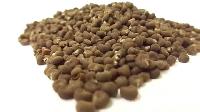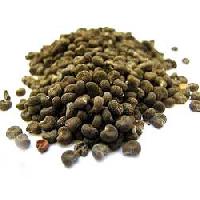
ambrette seeds
Get Price Quote

Ambrette Seed
Get Price Quote
The botanical name of ambrette is hibiscus abelmoschus l. It is a tropical hibiscus with beautiful bright yellow flowers, and its distinctive seed pods look so similar to okra that the plant is sometimes referred to as “musk okra” or “ornamental okra.” ambrette is native to india, where it is known as mushkdana or kasturi bhendi. The plant grows to just over a meter in height and is an evergreen shrub. When mature the pods split open to reveal kidney-shaped seeds that have a sweet, flowery, heavy fragrance. Ambrette has long been appreciated in perfumery as one of the few plant oils that contains natural musk compounds, including one named after the plant, ambrettolide. Many synthetic musks are cooked up in laboratories these days, but for people who care about natural products, there is no substitute for the natural. Ambrette oil is expensive and rare because so much work goes into creating it. Unlike some oil crops where the plant leaves are used, ambrette oil is made only from seeds, which weigh very little and must be carefully gathered. The seeds represent a tiny fraction of the biomass of the entire plant, and only a very small yield of essential oil is achieved -- 0.2% to 0.6% of the total weight of the seeds. In natural perfumery, it can be used in a wide range of compositions including musk bases, amber accords, high class florals, oriental bouquets, incense perfumes, fougere, and new mown hay. Ambrette oil is pale yellow, with an enchanting aroma described variously as sweet, rich, warm musky, fatty and nutty, with floral overtones. after a short period of aging, more complex notes can emerge, such as wine, brandy, fruit, and tobacco. Like all musks, ambrette is a perfumery base note.
Best Deals from Ambrette Seeds

Ambrette Seed
Get Price Quote
We offer Herbs that have found many uses in treating number of diseases without creating any side effects. Many of today's drugs and medicines were originally derived from natural ingredients, combinations of medicinal plants and other products found in nature. We export Botanical Herbs as the list shown below : Ambrette Seed (Musk Seed) Angelica Root Ammi Majus Seed Allim Sativum (Garlic) Annato Seeds Azadirachta Indica Fruit/leaves/Seeds (Neem) Adiantum Cap. Veneris Herb Andrographis Paniculata Herb Bacopa Monnieri HerbBerberis Roots Cascara Sagrada Root Catharanthus Roseus Leaves/Roots(Vinca roseus) Cassia Angustifolia Leaves/Pods (Senna) Carica Papaya Leaves Carthamus Tinctorius Petals (Safflower) Cinchona Ledgeriana Bark Coleus Forskohlii Root Cassia Obovata Leaves Cassia Tora Seeds Centella Asiatica Herb (Gotucola) Emblica Officinalis FruitGymnema Sylvestra Herb/Leaves Garcinia Cambogia Fruit Gloriosa Superba Seed Horse Chest Nuts ( Fruit) Hydrocotyle Asiatica Herb Hemidesmius indicus Indigofera Tinctoria Leaves Ipomoea hederacea Seeds. Java Green Tea Leaves Juniperus Communis Fruit Lawsonia Inermis Leaves/Powder (Henna)Lycopodium Clavantum Powder Mallotus Phillippinensis Powder Matricaria Chamomilla Flowers Mentha Arvensis / Piperita Leaves / Herb Mucuna Pruriens Seed Mappia Foetida Chips Momordica Charantia Fruit (Bitter Gourd) Passiflora Foetida Herb/leaves Plantago Ovata Husk/Husk Powder/ Seed (Psyllium) Phyllanthus Niruri Herb Gymnema Sylvestra Herb/Leaves GarciniaCambogia FruitGloriosa Superba Seed Horse Chest Nuts ( Fruit) Hydrocotyle Asiatica Herb Hemidesmius indicus Indigofera Tinctoria Leaves Ipomoea hederacea Seeds Java Green Tea Leaves Juniperus Communis Fruit Lawsonia Inermis Leaves/Powder (Henna) Lycopodium Clavantum Powder Mallotus Phillippinensis Powder Matricaria Chamomilla Flowers Mentha Arvensis / Piperita Leaves / Herb Mucuna Pruriens Seed Mappia Foetida Chips Momordica Charantia Fruit (Bitter Gourd) Passiflora Foetida Herb/leave Plantago Ovata Husk/Husk Powder/ Seed (Psyllium) Phyllanthus Niruri Herb.

Ambrette Seed
Get Price Quote

Musk Mallow Seeds
100 - 400 Per Kilogram
1 Kilogram (MOQ)
We are a trustworthy Supplier of Musk Mallow Seeds in Madhya Pradesh, India. We source the Seeds from the trustworthy and quality assured vendors who produce them in compliance with the international quality standards. The Seeds are commonly used as a substitute in perfumes for animal musk. Not only this, but they also has various culinary uses. In addition, the mucilage of the Seeds provide sizing for paper and hence are extensively used in paper industry. With the help of wide network, we are capable in providing timely delivery of the desired order.

MUSK AMBRETTE SEEDS
Get Price Quote
ABELMOSCHUS MOSCHATUS (musk ambrette seeds) Botanical Name ABELMOSCHUS MOSCHATUS Common Name musk ambrette seeds Category Herbs Product Description musk ambrette seeds : It removes foul smell of mouth and also very good for eye diseases. Seeds are very good sex tonic.

mushk dana
1,500 Per Kilogram
Common Name : Abelmoschus Moschatus | Mushk Dana | Musk Dana | Ambrette Seed | Dried Mushk Dana Botanical Name : Abelmoschus Moschatus Products : Mushk Dana Form Available : Powder / Churan Ingredient Used : Seed Country Of Origen : India Trade : Wholesale Speciality : Made From Pure, Authentic And Original Herbs. Domestic Courier Partners :- Delivery Blue Dart, TCI Freight, DTDC. About this item Ingredients: Mushk Dana Cuisine : Indian Specialty: No Artificial Colors, Fresh & Pure Country of Origin: India.

Ambrette Seed
Get Price Quote
The botanical name of Ambrette is Hibiscus abelmoschus L. It is a tropical hibiscus with beautiful bright yellow flowers, and its distinctive seed pods look so similar to okra that the plant is sometimes referred to as “musk okra” or “ornamental okra.” Ambrette has long been appreciated in perfumery as one of the few plant oils that contains natural musk compounds, including one named after the plant, ambrettolide. Many synthetic musks are cooked up in laboratories these days, but for people who care about natural products, there is no substitute for the natural.

Ambrette Seed
200 Per Kilogram
50 Kilogram (MOQ)

Ambrette Seed
Get Price Quote

Ambrette Seed
335 Per
50 Kilogram (MOQ)

Ambrette Seed
95,000 Per Kilogram
1 Kilogram (MOQ)

Ambrette Seeds, Hibiscus Abelmoschus
Get Price Quote
Ambrette Seeds, Hibiscus Abelmoschus, Olive Oil, Kalonji Oil, Kulthi Daal

Ambrette Seed
Get Price Quote
Ambrette Seed, vanilla seeds, Barley Seeds

ambrette seeds
Get Price Quote
ambrette seeds, other herbal products, Senna Leaves

ambrette seeds
Get Price Quote
ambrette seeds

ambrette seeds
Get Price Quote
ambrette seeds, Plantation Seeds, Amaranthus Caudatus Seeds, Garlic Seeds

Ambrette Seed
Get Price Quote
Ambrette Seed, Natural Herbs, Lavender Flower, Thyme Leaves, Cultivator

Ambrette Seed
Get Price Quote
Ambrette Seed, paddy seed, Hybrid Chilli Seeds

Ambrette Seed
Get Price Quote
Ambrette Seed, Spices, Senna Leaves, Edible Oils, Chilly, Dried Red Chili